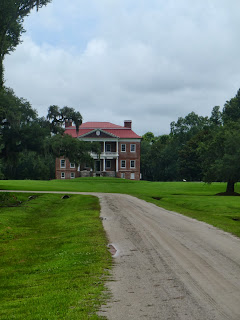While my husband was working I decided to
explore Drayton Hall.
Which wasn't to far from where we were living.
I even got a coupon for half off
I'm getting better at finding good deals.
| |||||||||||||||||||||||||||||||||||||||||||||||

Location – Ashley River, West Ashley, St. Andrew's Parish, Charleston County
Located at 3380 Ashley River Road (Highway 61)
Origin of name – Named for John Drayton, an early owner
Current status – Owned by the National Trust for Historic Preservation and open to the public.
 The mansion was built for John Drayton (c. 1715-1779) after he bought the property in the late 1730s.[3] As the third son in his family, he knew he was unlikely to inherit his own nearby birthplace, now called Magnolia Plantation and Gardens
The mansion was built for John Drayton (c. 1715-1779) after he bought the property in the late 1730s.[3] As the third son in his family, he knew he was unlikely to inherit his own nearby birthplace, now called Magnolia Plantation and Gardens
(Didn't get to visit the Magnolia Gardens or Middleton Place)
Each park has an entrance fee. I would love to go back so
hopefully next time I can see them all.
Timeline
- 1678 – Earliest known date of existence when Edward Mayo received a land grant for 750 acres (Ashley River Historic District National Register, p. 51).
- 1680 or 1681 – Mayo sold the property to Joseph Harbin. Harbin constructed a house on the property (Ashley River Historic District National Register, p. 51, 53).
The property changed hands several times and was subdivided (Ashley River Historic District National Register, p. 51).
- 1738 – John Drayton purchased the property from John Greene and began constructing a new house (Ashley River Historic District National Register, p. 51).
Circa 1742 – The house was completed (Ashley River Historic District National Register, p. 52).
1779 – John Drayton died leaving Drayton Hall to his fourth wife Rebecca (Ashley River Historic District National Register, p. 52).
1783 – Rebecca sold the plantation to her step-son, Charles Drayton (Ashley River Historic District National Register, p. 52).
1820 – Charles died, willing the plantation to his son Dr. Charles Drayton II (Ashley River Historic District National Register, p. 52).
1844 – At the death of Charles II, Drayton Hall remained in the Drayton family and did so for a total of seven generations (Ashley River Historic District National Register, p. 52).
More commercial activities started to take place at the plantation with the growing of rice, cotton and mining of phosphate (Ashley River Historic District National Register, p. 52).
1974 – The house was acquired by the National Trust for Historic Preservation.
1977 – Drayton Hall was opened to the public
A little bored while waitig for my tour to start
so taking some selfies photos.
Land
- Number of acres – 750 acres in 1678; 350 in 1738; When the Drayton family sold the property to the National Trust in 1974, they sold 633 acres. Today the National Trust holds 125 acres, and the State of South Carolina holds the balance.
- Primary crop – Cotton, rice, phosphate (Ashley River Historic District National Register, p. 52-53)
Buildings
- Today Drayton Hall consists of the main house and privy. The main house originally was complete with two flanker buildings: the kitchen flanker and laundry flanker; however, an earthquake destroyed the laundry flanker in 1886 and a hurricane destroyed the kitchen flanker in 1893.
- The Museum Shop is housed in one of the two surviving historic outbuildings of Drayton Hall - the wood frame caretaker's house, built in the late 1800s.
Basement/bottom floor. Kitchen.
Slaves
- Number of slaves – The number of slaves that lived at Drayton Hall varied from year to year. The average number of slaves reported by the census to be living at Drayton Hall between 1790 and 1860 is 45.
only plantation house on the Ashley River to survive intact through both the Revolutionary and Civil wars, it is a National Historic Landmark.
A nice gentelman took this photo for me.
Walking Trail
A view of the Drayton Hall along the trail.
Drayton Hall cemetery of the family members.
It had rained a lot and was still raining as I took my walk.
Had to walk in a small swamp to get these photos almost lost my shoes.
Drayton family members use to canoe in this man made lake.



















































No comments:
Post a Comment